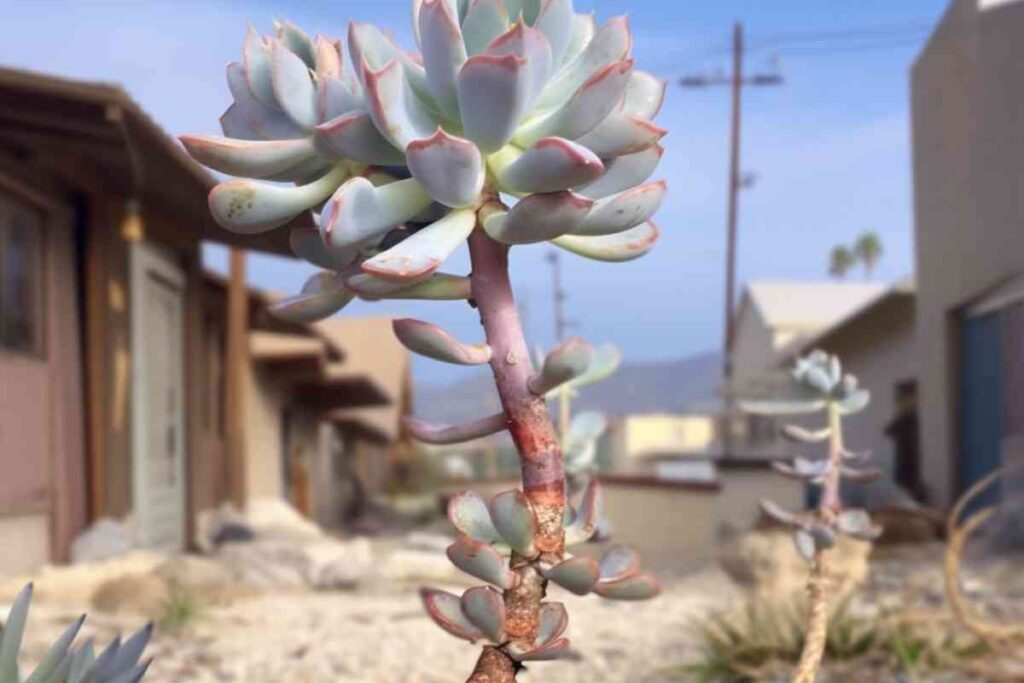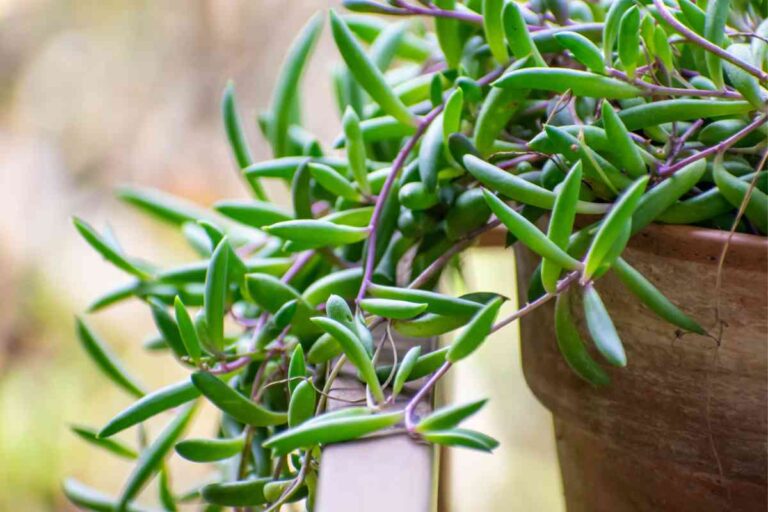How to Fix Leggy Succulents: Expert Tips for Healthier Plants

Even the most experienced gardeners sometimes encounter leggy succulents. Leggy succulents are those that have grown tall and thin, with a stretched-out appearance.
Don’t worry, you can fix your leggy succulents and get them looking lush and compact again. I’ll guide you through my top tips for fixing a leggy succulent.

Fixing a leggy succulent depends on correcting whatever made it leggy in the first place, along with taking measures to make it grow more compactly. From pruning to encourage lush growth to learning how to regenaate growth on the stem, here’s what you need to know about fixing leggy succulents.
Struggling to grow succulents that don’t get leggy no matter what you try. It’s ok to throw in the towel. Here are my best ideas for gardening with artificial succulents.
Have your succulents roots rotted from whatever made your succulent leggy? Here’s how to save a rootless succulent.
How do I Fix Leggy Succulents?
To fix leggy succulents, propagate the succulent from its stem and/or leaves or repot the succulent with the leggy stem buried in the soil. For succulents that don’t propagate from stems or leaves, try beheading and propagating by cutting the top part and letting it callous before planting. You can also prune back stretched stems or use stakes to support them.
Causes of Legginess in Succulents
Succulents are known for their compact and attractive appearance, but they can become leggy or stretched out because of inadequate sunlight, improper watering, and incorrect soil type.
Inadequate Sunlight
The main reason why succulents start to stretch out is due to inadequate sunlight. Succulents require a lot of sunlight to maintain their compact shape and vibrant colors. When they do not receive enough sunlight, they start to stretch out in search of more light and become pale and weak looking. This can happen within a couple of weeks. The first sign of legginess is the succulent starting to bend towards the sun.
To prevent legginess due to inadequate sunlight, make sure to place your succulents in a spot where they can receive adequate sunlight. If you are growing succulents indoors, place them near a window that receives direct sunlight. Don’t have enough light? A grow light for indoor cacti and succulents is a great solution. If you are growing them outdoors, make sure to choose a spot that receives plenty of sunlight throughout the day.

Improper Watering
Overwatering or underwatering succulents can also cause legginess. When succulents receive too much water, their leaves become soft and weak, and they start to stretch out. On the other hand, when succulents receive too little water, their leaves become shriveled and dry, and they also start to stretch out.
To prevent legginess due to improper watering, make sure to water your succulents correctly. Water them deeply but infrequently, allowing the soil to dry out completely before watering again. Also, make sure to use a well-draining soil mix that allows excess water to drain away quickly.
Incorrect Soil Type
Using the wrong soil type can also cause legginess in succulents. Succulents require a well-draining soil mix that allows excess water to drain away quickly. If the soil mix is too dense or retains too much moisture, the succulents will become waterlogged, and their leaves will become soft and weak, causing them to stretch out.
To prevent legginess due to incorrect soil type, make sure to use a well-draining soil mix that contains ingredients like coarse sand and pumice. These materials help to improve drainage and prevent waterlogging, which can cause legginess in succulents.
Preventing Leggy Succulents
- Proper Light: Succulents thrive in bright, indirect sunlight. Place them near a sunny window or provide them with filtered light. Avoid keeping them in dimly lit areas, as this can lead to stretching and legginess as they reach for more light.
- Watering: Allow the soil to dry out completely between waterings. Overwatering can cause weak growth and root rot, leading to leggy succulents. Use the “soak and dry” method, where you thoroughly water the plant and then wait until the soil is dry before watering again.
- Well-Draining Soil: Use a well-draining succulent or cactus soil mix. Proper drainage prevents waterlogged roots and helps maintain the right moisture level in the soil.
- Limited Fertilization: While succulents do require nutrients, over-fertilization can lead to excessive growth and legginess. Use a balanced, diluted fertilizer or a specialized succulent fertilizer sparingly during the growing season.
- Shallow Container with Drainage: Plant succulents in shallow containers with drainage holes. This ensures excess water can escape and roots to grow naturally, preventing root rot and other water-related issues.
- Pruning: Regular pruning throughout the succulent’s life is crucial to maintaining its shape and preventing legginess. Trim back elongated stems to encourage branching and compact growth. Always use clean, sharp pruning shears to avoid damaging the plant.
- Rotate the Plant: To ensure even growth and prevent leaning towards the light source, rotate the succulent occasionally, allowing all sides to receive sunlight.
- Provide Adequate Space: Avoid crowding succulents together, as this can lead to competition for light and space, causing them to stretch towards the light source.
- Monitor Temperature: Keep succulents in a temperature range that suits their needs. Avoid extreme fluctuations, as sudden temperature changes can stress the plants and affect their growth.

Fixing Leggy Succulents
Pruning
Pruning is the process of trimming away the excess growth on your succulent to encourage new growth and a more compact shape. It’s also a great way to propagate succulents. To prune your leggy succulent, you will need a pair of sharp scissors or pruners.
Start by cutting off the top of the succulent stem, leaving a few inches of stem with a rosette of leaves intact. Keep going down the stem, making sure to cut just above a leaf node to encourage new growth. Once you have made your cuts, leave the stems to callus over for a few days before planting them in well-draining soil. Each stem cutting will become its own compact plant.
Leaf Cuttings and Stem Regeneration
Sure! Fixing a leggy succulent using leaf cuttings is a simple and effective method to propagate new compact succulents. Here’s a step-by-step guide on how to do it:
Carefully pluck or cut off all the leaves from the leggy stem. Gently twist and pull the leaves to ensure they come off cleanly. Be sure to discard any leaves that appear damaged or unhealthy.
Place the detached leaves and stem on a dry surface, like a paper towel or tray, and allow them to callous for a day or two. Callousing is essential for preventing rot when you plant the leaves.

Choose an appropriate well-draining succulent soil mix. Lay the calloused stem flat on the soil surface. It’s essential to place it horizontally, as this encourages the growth of new succulents from the stem. Nestle it into the soil so roots will be encouraged to grow. The leaves can be set with their stems just under the surface of the soil to encourage root formation.
Place the leaf cuttings and the stem cutting in a location with bright, indirect light. Avoid direct sunlight, as it may cause the cuttings to dry out or scorch. Water sparingly, allowing the soil to dry out between waterings.
Over time, the leaf cuttings will start to develop roots, and new tiny succulents will emerge from the base of the leaves. The stem cutting should also begin to sprout new growth along its length.
Once the new succulents have grown to a reasonable size and have established roots, you can carefully transplant them into individual pots or a larger container, following the usual care routine for mature succulents.

Repotting
Repotting is the process of moving your succulent to a new pot with fresh soil. This method can help fix leggy succulents by providing them with fresh nutrients and space to grow.
To repot your leggy succulent, gently remove it from its current pot and shake off any excess soil. Trim away any dead or damaged roots and leaves and plant the succulent in a pot with fresh, well-draining soil.
Plant it with the roots and stem up to the first leaves in the soil. It’s best to lay the stem horizontally under the soil if possible. The tip will soon bend up to reach the sun, creating the effect of a smaller, more compact plant. More new growth will come up along the length of the stem.
Common Succulents and How to Deal with Legginess
| Succulent Name | Propagation Method | Leggy Solution |
|---|---|---|
| Echeveria | Both (Stem & Leaf) | Stem Propagation: Behead and replant healthy rosettes. |
| Leaf Propagation: Let leaves callous, plant in soil. | ||
| Leggy Solution: Behead, callous, replant stem or leaves. | ||
| Prune to encourage branching. | ||
| Sedum | Stem | Stem Propagation: Cut healthy stem, plant in soil. |
| Leggy Solution: Prune back, replant stem cuttings. | ||
| Aloe | Both (Stem & Leaf) | Stem Propagation: Behead, replant healthy offsets. |
| Leaf Propagation: Let leaves callous, plant in soil. | ||
| Leggy Solution: Behead, callous, replant stem or leaves. | ||
| Prune off leggy growth, encourage new offsets. | ||
| Crassula ovata | Stem | Stem Propagation: Cut healthy stem, plant in soil. |
| Leggy Solution: Prune back, replant stem cuttings. | ||
| Haworthia | Leaf | Leaf Propagation: Let leaves callous, plant in soil. |
| Leggy Solution: Remove leggy leaves, encourage offsets. | ||
| Kalanchoe | Both (Stem & Leaf) | Stem Propagation: Cut healthy stem, plant in soil. |
| Leaf Propagation: Let leaves callous, plant in soil. | ||
| Leggy Solution: Behead, callous, replant stem or leaves. | ||
| Prune back to encourage new growth. | ||
| Senecio rowleyanus | Stem | Stem Propagation: Cut healthy stem, plant in soil. |
| Leggy Solution: Prune back, replant stem cuttings. | ||
| Sempervivum | Both (Stem & Leaf) | Stem Propagation: Behead, replant healthy rosettes. |
| Leaf Propagation: Let leaves callous, plant in soil. | ||
| Leggy Solution: Behead, callous, replant stem or leaves. | ||
| Prune to encourage new offsets. | ||
| Pachyphytum | Stem | Stem Propagation: Cut healthy stem, plant in soil. |
| Leggy Solution: Prune back, replant stem cuttings. | ||
| Portulacaria afra | Stem | Stem Propagation: Cut healthy stem, plant in soil. |
| Leggy Solution: Prune back, replant stem cuttings. |
What If You Have a Leggy Succulent that Can’t be Propagated by Leaf or Stem Cuttings?
- Behead and Propagate: For certain types of succulents, you can try beheading the leggy plant. Use sharp, clean scissors or pruning shears to cut off the top portion of the succulent, leaving a stem with healthy leaves intact. Let the beheaded stem callous for a day or two and then plant it in well-draining soil. This method encourages new growth from the cut end of the stem. The remaining lower portion of the leggy succulent may also produce new side shoots over time.
- Prune and Shape: If the leggy succulent has some healthy growth at the top, you can prune the leggy stems to encourage branching. Trim back the long, stretched-out stems to a desired length, just above a healthy leaf node. This can stimulate new growth and result in a more compact and bushier appearance over time.
- Support the Plant: If the leggy succulent has weak or drooping stems, you can use small stakes or supports to prop up the plant and encourage it to grow more upright.
- Consider Replanting: Sometimes, a leggy succulent may have outgrown its current container. If you notice roots emerging from the drainage holes or if the plant is becoming top-heavy, it might be time to replant it in a larger container with fresh succulent soil.
Common Succulents Difficult to Propagate with Cuttings and How to Make Them Less Leggy
- Agave: Agaves are primarily propagated through offsets, which are small baby plants that form around the base of mature plants. If an Agave becomes leggy, it is challenging to remedy. In such cases, the best course of action is to remove the leggy plant and replace it with a healthy, younger Agave.
- Gasteria: Gasterias can be tricky to propagate from stem or leaf cuttings. If a Gasteria becomes leggy, it is challenging to encourage new growth from the existing plant. The best approach is to cut back the leggy growth and encourage the plant to produce new offsets from the base.
- Lithops: Lithops, also known as “living stones,” have a unique growth pattern, and propagating them from cuttings is not feasible. If a Lithops becomes leggy, it is usually a sign of inadequate light or improper care. To rectify this, adjust the plant’s growing conditions by providing more light and ensuring well-draining soil.
- Rhipsalis: Rhipsalis is an epiphytic succulent, and propagating it from stem or leaf cuttings is generally unsuccessful. If a Rhipsalis becomes leggy, you can try pruning back the elongated stems to encourage branching and promote a more compact growth habit.

Don’t have much space with the right conditions for succulents? Succulent mini gardens are a superb solution. They can fit onto any windowsill or snuck onto the sunny spot of any counter.
Outdoor succulents get leggy when they’re too hot with too little water. Get the best succulents for hot sun to avoid this problem.
Frequently Asked Questions
How do you prune a succulent to prevent it from growing leggy?
To prevent your succulent from growing leggy, you can prune it regularly. Pruning encourages the plant to grow bushier and more compact. To prune your succulent, simply cut off the top part of the stem with a clean, sharp pair of scissors or pruning shears. You can also pinch off the tips of the leaves to encourage branching.
How do you propagate a leggy succulent?
Propagating a leggy succulent is a great way to rejuvenate the plant and create new, healthy growth. To propagate a leggy succulent, you can take stem cuttings or leaf cuttings. Simply cut off a healthy stem or leaf and let it dry out for a few days. Then, plant the cutting in well-draining soil and water sparingly until it roots and starts to grow.
What causes succulents to grow tall and leggy?
Succulents typically grow tall and leggy when they don’t get enough sunlight. When a succulent doesn’t get enough light, it will stretch out in search of more, causing it to become tall and thin. Overwatering and over-fertilizing can also contribute to leggy growth.
What are some tall succulent types that don’t grow leggy?
Some tall succulent types that don’t grow leggy include the Euphorbia trigona, Aloe vera, and Agave americana. These plants naturally grow tall and upright without becoming leggy.
Can you fix a leggy succulent by cutting it back?
Yes, you can fix a leggy succulent by cutting it back. Cutting back a leggy succulent will encourage new growth and help the plant become more compact and bushy. Simply cut off the top part of the stem with a clean, sharp pair of scissors or pruning shears.
Is it possible to regrow a succulent from a cut stem?
Yes, it is possible to regrow a succulent from a cut stem. Simply take a healthy stem cutting and let it dry out for a few days. Then, plant the cutting in well-draining soil and water sparingly until it roots and starts to grow. With proper care, the cutting will grow into a new, healthy succulent plant.
To prevent your succulent from growing leggy, you can prune it regularly. Pruning encourages the plant to grow bushier and more compact. To prune your succulent, simply cut off the top part of the stem with a clean, sharp pair of scissors or pruning shears. You can also pinch off the tips of the leaves to encourage branching.
“}},{“@type”:”Question”,”name”:”How do you propagate a leggy succulent?”,”acceptedAnswer”:{“@type”:”Answer”,”text”:”
Propagating a leggy succulent is a great way to rejuvenate the plant and create new, healthy growth. To propagate a leggy succulent, you can take stem cuttings or leaf cuttings. Simply cut off a healthy stem or leaf and let it dry out for a few days. Then, plant the cutting in well-draining soil and water sparingly until it roots and starts to grow.
“}},{“@type”:”Question”,”name”:”What causes succulents to grow tall and leggy?”,”acceptedAnswer”:{“@type”:”Answer”,”text”:”
Succulents typically grow tall and leggy when they don’t get enough sunlight. When a succulent doesn’t get enough light, it will stretch out in search of more, causing it to become tall and thin. Overwatering and over-fertilizing can also contribute to leggy growth.
“}},{“@type”:”Question”,”name”:”What are some tall succulent types that don’t grow leggy?”,”acceptedAnswer”:{“@type”:”Answer”,”text”:”
Some tall succulent types that don’t grow leggy include the Euphorbia trigona, Aloe vera, and Agave americana. These plants naturally grow tall and upright without becoming leggy.
“}},{“@type”:”Question”,”name”:”Can you fix a leggy succulent by cutting it back?”,”acceptedAnswer”:{“@type”:”Answer”,”text”:”
Yes, you can fix a leggy succulent by cutting it back. Cutting back a leggy succulent will encourage new growth and help the plant become more compact and bushy. Simply cut off the top part of the stem with a clean, sharp pair of scissors or pruning shears.
“}},{“@type”:”Question”,”name”:”Is it possible to regrow a succulent from a cut stem?”,”acceptedAnswer”:{“@type”:”Answer”,”text”:”
Yes, it is possible to regrow a succulent from a cut stem. Simply take a healthy stem cutting and let it dry out for a few days. Then, plant the cutting in well-draining soil and water sparingly until it roots and starts to grow. With proper care, the cutting will grow into a new, healthy succulent plant.
“}}]}



